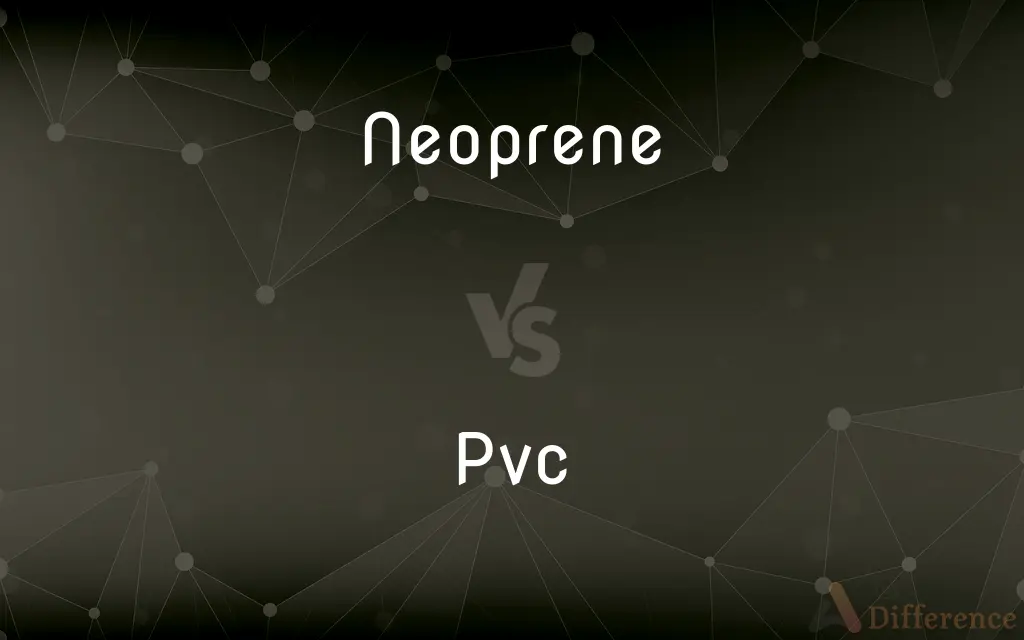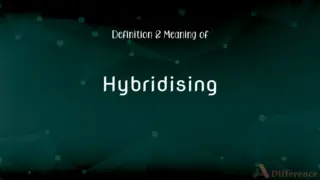Neoprene vs. PVC — What's the Difference?
By Tayyaba Rehman & Urooj Arif — Updated on March 6, 2024
Neoprene is a synthetic rubber known for its chemical stability and flexibility across temperatures, whereas PVC is a rigid plastic popular for its durability and cost-effectiveness.

Difference Between Neoprene and PVC
Table of Contents
ADVERTISEMENT
Key Differences
Neoprene, a synthetic rubber, offers superior resistance to oils, chemicals, and weathering, making it ideal for protective gear and wetsuits. Its elasticity and durability under varying temperatures allow for widespread use in automotive and medical industries. On the other hand, PVC, or polyvinyl chloride, is a versatile plastic that stands out for its strength, lightweight, and resistance to environmental factors like water and fire. Its rigidity and ease of manufacturing make it a common choice for construction materials, pipes, and medical devices. While neoprene excels in flexibility and chemical resistance, PVC offers unmatched practicality and cost-efficiency in rigid product applications.
The thermal properties of neoprene allow it to maintain flexibility and insulation in both hot and cold environments, making it suitable for thermal wear and insulation applications. In contrast, PVC has a relatively narrow temperature range before becoming brittle in cold or softening in heat, limiting its use in applications requiring thermal stability.
From an environmental perspective, neoprene's production and disposal raise concerns due to its synthetic nature and the chemicals involved in its manufacturing process. PVC, while also a synthetic material, has faced criticism for releasing harmful chlorine-based chemicals during production and disposal. However, recycling initiatives and advancements in manufacturing technologies are addressing these environmental impacts for both materials.
Neoprene's versatility extends to its ability to be laminated with other materials, enhancing its application scope in consumer goods like laptop sleeves and orthopedic braces. PVC's adaptability lies in its formulation; by adjusting plasticizers, it can range from rigid to flexible, broadening its use from construction materials to flexible hoses and tubing.
Despite their differences, both neoprene and PVC play crucial roles in modern manufacturing, each offering unique benefits. The choice between neoprene and PVC ultimately depends on the specific requirements of the application, including flexibility, temperature resistance, and environmental considerations.
ADVERTISEMENT
Comparison Chart
Material Type
Synthetic rubber
Synthetic plastic
Key Properties
Flexibility, chemical stability, weather resistance
Durability, lightweight, fire resistance
Temperature Resistance
High (maintains properties across wide temperatures)
Moderate (susceptible to brittleness or softening)
Environmental Impact
Concerns over chemicals in manufacturing & disposal
Chlorine-based chemical concerns in production & disposal
Applications
Protective gear, automotive, medical devices
Construction materials, pipes, medical devices
Compare with Definitions
Neoprene
A synthetic rubber resistant to oil, heat, and weathering.
Neoprene suits are popular among divers for their insulation properties.
Pvc
Common in construction materials like window frames for its weather resistance.
PVC windows withstand diverse climates without warping.
Neoprene
Employed in consumer goods like laptop cases for shock absorption.
Neoprene sleeves protect laptops from impacts.
Pvc
Used in medical devices for its sterilizability and clarity.
PVC tubing is essential in hospital IV systems.
Neoprene
Common in automotive gaskets due to its chemical stability.
Neoprene gaskets seal car engines against fluids.
Pvc
Employed in packaging for its clarity and strength.
PVC packaging protects goods during transport and display.
Neoprene
Suitable for industrial applications requiring resistance to degradation.
Neoprene hoses resist harsh chemicals in factories.
Pvc
Flexible forms are used in wiring insulation for electrical safety.
PVC-coated wires prevent electrical hazards.
Neoprene
Used in medical supports for its flexibility and durability.
Neoprene knee braces offer support while allowing movement.
Pvc
A versatile synthetic plastic known for its strength and rigidity.
PVC pipes are used widely in plumbing for their durability.
Neoprene
Neoprene (also polychloroprene) is a family of synthetic rubbers that are produced by polymerization of chloroprene. Neoprene exhibits good chemical stability and maintains flexibility over a wide temperature range.
Pvc
Irregularity of cardiac rhythm; recurrent occurrences can be a precursor of ventricular fibrillation
Neoprene
A synthetic rubber produced by polymerization of chloroprene and used in weather-resistant products, adhesives, shoe soles, sportswear, paints, and rocket fuels.
Pvc
A polymer of vinyl chloride used instead of rubber in electric cables
Neoprene
A synthetic rubber, a polymer of chloroprene, commonly used in wetsuits, laptop sleeves, orthopedic braces, electrical insulation, liquid and sheet-applied elastomeric membranes and flashings, car fan belts, etc.
Neoprene
A synthetic rubber that is resistant to oils and aging; used in waterproof products
Common Curiosities
Is neoprene waterproof?
Yes, neoprene is waterproof, making it suitable for aquatic and outdoor gear.
Are there health concerns associated with PVC?
Health concerns with PVC primarily relate to the release of chlorine-based chemicals during production and disposal.
What is neoprene best used for?
Neoprene is ideal for applications requiring chemical resistance, flexibility, and thermal insulation, such as wetsuits and automotive gaskets.
Can PVC be recycled?
Yes, PVC can be recycled, which reduces its environmental footprint.
What is PVC best used for?
PVC is best suited for construction materials, plumbing pipes, and medical devices due to its durability, chemical resistance, and cost-effectiveness.
Can PVC be made flexible?
Yes, PVC can be made flexible with the addition of plasticizers, expanding its use to products like cables and tubing.
Can neoprene be used in medical applications?
Yes, neoprene's flexibility and durability make it suitable for various medical supports and devices.
How does weathering affect neoprene and PVC?
Neoprene resists degradation from weathering and UV light, while PVC's resistance varies with its formulation, generally holding up well.
How do neoprene and PVC compare in terms of chemical resistance?
Neoprene offers superior chemical resistance compared to PVC, especially against oils and solvents.
Is neoprene environmentally friendly?
Neoprene raises environmental concerns due to its synthetic nature and the chemicals used in its production, though efforts are made to mitigate these impacts.
How does temperature affect neoprene and PVC?
Neoprene maintains its properties across a wide range of temperatures, whereas PVC can become brittle in cold or soften in heat.
What are the key differences in the application of neoprene and PVC?
Neoprene is favored for its flexibility and thermal insulation in protective gear, while PVC is preferred for its rigidity and cost-effectiveness in construction and medical devices.
Can neoprene and PVC be used together in products?
Yes, neoprene and PVC can be used together, leveraging the unique properties of each for complex applications.
How are neoprene and PVC produced?
Both materials are synthetically produced through polymerization processes, with specific chemicals and conditions tailored to each.
Is PVC cost-effective compared to neoprene?
PVC is generally more cost-effective than neoprene, especially in applications requiring rigid materials.
Share Your Discovery

Previous Comparison
Rhododendron vs. Magnolia
Next Comparison
Misadventure vs. AdventureAuthor Spotlight
Written by
Tayyaba RehmanTayyaba Rehman is a distinguished writer, currently serving as a primary contributor to askdifference.com. As a researcher in semantics and etymology, Tayyaba's passion for the complexity of languages and their distinctions has found a perfect home on the platform. Tayyaba delves into the intricacies of language, distinguishing between commonly confused words and phrases, thereby providing clarity for readers worldwide.
Co-written by
Urooj ArifUrooj is a skilled content writer at Ask Difference, known for her exceptional ability to simplify complex topics into engaging and informative content. With a passion for research and a flair for clear, concise writing, she consistently delivers articles that resonate with our diverse audience.














































